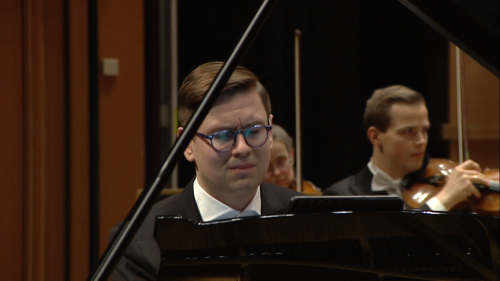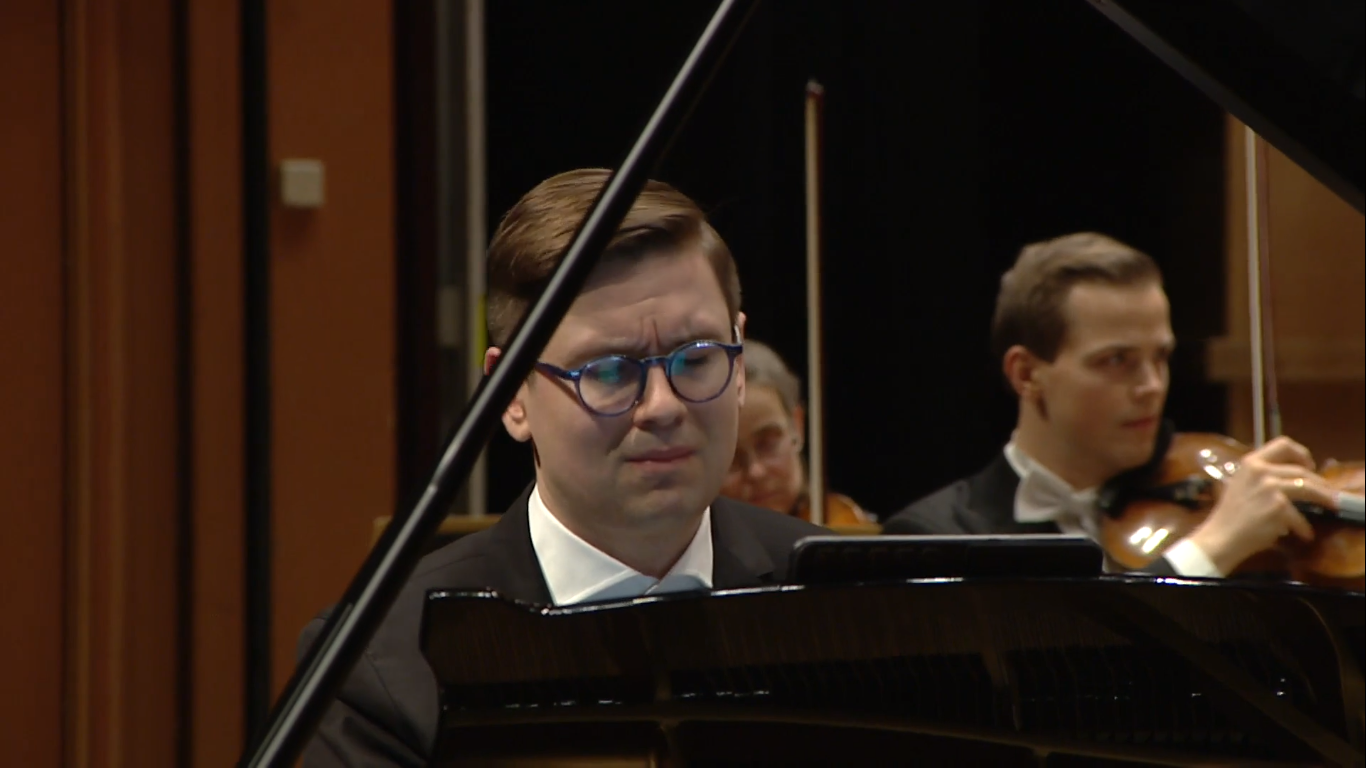 Norway Glass/Badzura, Bach, Mozart – Víkingur Ólafsson (piano): Bergen Philharmonic Orchestra / Edward Gardner (conductor). Livestream from BergenPhiLive: Wintermezzo (click here), 7.2.2021. (CC)
Norway Glass/Badzura, Bach, Mozart – Víkingur Ólafsson (piano): Bergen Philharmonic Orchestra / Edward Gardner (conductor). Livestream from BergenPhiLive: Wintermezzo (click here), 7.2.2021. (CC)

Glass – Glassworks: Opening (1981, reworked by Christian Badzura)
Bach – Keyboard Concerto No.5 in F minor, BWV 1056 (1738); Violin Sonata No.5 in F minor, BWV 1018: Adagio (1717-23, arr. Ólafsson)
Mozart – Serenade No.12 in C minor for winds, K 388/384a (1782); Piano Concerto No.24 in C minor, K 491 (1786, cadenza Ólafsson)
Bergen Philharmonic Orchestra’s series and introduced on this occasion by Henning Målsnes. The concert focused on their musician-in-residence, Víkingur Ólaffson; the announcements, plus a conversation between Ólaffson and Edward Gardner, were all in English.
Lovely to see an audience of some 200 people there, clearly socially distanced. Gardner has remained in Norway during the coronavirus pandemic, and his rapport with the orchestra was clear throughout.
Víkingur Ólafsson has long been associated with the music of Glass. Glassworks was an attempt to create a Walkman-suitable release (the cassette was specially mixed: ‘hopefully some of you know what a cassette player is’, quipped Målsnes). It was fascinating to hear how Ólafsson casts the spell of the music immediately; and that something ostensibly so simple can speak so deeply. The sound on the web transmission is remarkable; we heard the pizzicato string reinforcing of the piano left-hand with precision, and when more strings enter with staccato repeated figures, they sounded utterly alive; what was most notable was the emotional range of the performance.
Good that the performance went straight into the Bach; one can hear the shared cleanliness of texture and the direct communication to the listener the composers share. Gardner clearly trying to elicit the last drop from his players; with Ólafsson perhaps just that bit less Romanticised; a hypnotic central Largo was simply beauty incarnate, though, Ólafsson’s cantabile right-hand melody an endless flow from the heart, each note exquisitely weighted within the whole. Rigour is the watchword of Ólafsson’s finale (a Presto). The concerto was followed by Ólafsson’s transcription of the Adagio from the F minor Violin Sonata, BWV 1018, a moment of still beauty, the right to left hand imitations perfectly equal in Ólafsson’s hands, a serene dialogue between two friends entirely in accord. How perfectly judged, too, the end.
The chat between conductor and pianist mentioned that Ólafsson has gone through quarantine twice to be there for a three-concert residency: ‘You don’t have to thank me because I wouldn’t want to be anywhere else on the planet currently than Bergen’, said Ólafsson, while also explaining the thoughts behind the concert’s programme: two keys, F minor and C minor; Bach and Mozart, to emphasise Mozart’s love for Bach and how Bach changed Mozart’s life when Mozart discovered him in 1781. Mozart was already some 25 years, but the music after that – late operas, symphonies – changed irrevocably. One need only think of the relationship between Mozart’s Fantasy in C minor the theme of Bach’s Musikalisches Opfer.
Talking of C minor, this was the point at which the concert switched from its F minor plateau to C minor with one movement from the Serenade in C minor – the Menuet and Trio. We don’t know who he wrote the Serenade for, and it is unique in its minor-mode cast. Ólafsson suggests a premonition of Schubert in this movement, a piece shot through with canons, with the trio having the melody in inversion. Gardner did not conduct this – he stood and watched, while Ólafsson listened intently from the keyboard. A perfect showcase for the Bergen Philharmonic’s excellent woodwind section, it was the perfect choice.
Ólafsson described Mozart’s Piano Concerto No.24 (C minor) as a piece of ‘three different times – his most extraordinary concerto, the most daring, the most experimental. He’s looking forward to the nineteenth century – the first movement is really a piano-symphony’. The second movement in contrast is very Classical, the third movement ‘one of his most extraordinary creations’ a theme and variations that goes back to Bach.
Gardner’s orchestral exposition for the Mozart 24th Concerto was exceptional: powerful, intense. Wind contributions were similarly exemplary. Ólafsson moulded his playing expertly to Mozart’s chosen mode of discourse, ever stylish. Rarely has this concerto seemed so close to Beethoven’s C minor Third Concerto (a parallel aided by my recent auditioning of Phillip Kawin’s sterling account with the Russian National Orchestra and Gerard Schwarz on the Master Performers label).
Mozart did not leave a cadenza for this concerto; and Ólafsson opted to play his own; as one might expect, it was fascinating, intelligent, and stylish. The central movement was so restful; after hearing the movement from the wind serenade, it was impossible not to link that to the wind contributions; the programming colours our hearing. Gardner was very alive to the orchestral contributions here, while Ólafsson risked the quietest pianissimi.

Ólafsson’s ornaments were ultra-tight in the finale; also, his lower register textures have intensity but no loss of clarity. Again, the clarinet-led variation brings us back to the Harmoniemusik vibe; but now the piano is able to react. A fabulous performance.
The encore was a repeat performance of Ólafsson’s Bach transcription. Also, on the BergenPhiLive website is a tremendous Grieg Piano Concerto (heard as the end point of a programme of Bartók, Luget, a single Grieg Lyric Piece, and Stravinsky and a simply astonishing performance of Daniel Bjarnason’s Processions, a piano concerto and a piece of wide musical vocabulary written for Ólafsson. Innocuous wind motifs are punctuated by immense metallic percussion thumps, but the piano writing is often lyrical, even hinting at post-Rachmaninov. The piece is terrific and also well worth catching; granitic dissonances sit cheek-by-jowl to long, post-Romantic melodies and odd moments that seem to clear to an almost Bachian counterpoint. You can buy Ólafsson’s recording of Bjarnason’s work on Bandcamp click here (the same website used by the Manchester Collective, incidentally).
Colin Clarke
